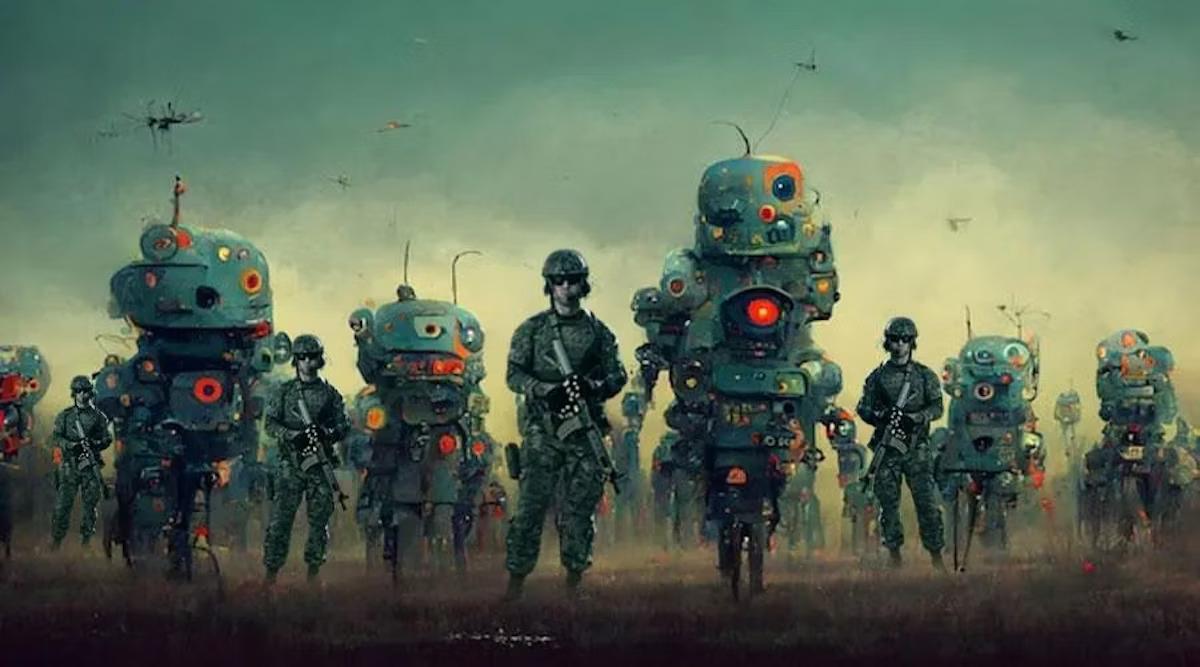The Future of DefSec: Defense Transitioning from Human to Machine with AI and Robotics

The defense and security (defsec) industry is undergoing a profound transformation driven by advancements in artificial intelligence (AI) and robotics. This evolution is not just a possibility but a necessity for the secure nations of the future. The integration of AI and robotics into armed forces promises enhanced capabilities, greater precision, and a significant reduction in human risk. This comprehensive article will explore the various facets of this transition, divided into three key parts: Enhanced Operational Efficiency and Human Safety, Superior Combat Capabilities and Cybersecurity, and Strategic Considerations and Future Implications.
Enhanced Operational Efficiency and Human Safety
Enhanced Operational Efficiency
The integration of AI and robotics into DefSec operations is revolutionizing operational efficiency. Machines, equipped with sophisticated AI, can process vast amounts of data rapidly, make real-time decisions, and execute complex tasks without fatigue or error. This shift enables more effective surveillance, reconnaissance, and combat operations, ultimately transforming the strategic landscape of national defense.
Key Advantages:
Real-Time Data Processing: AI systems can analyze live data from various sources, such as satellites, drones, and ground sensors, to provide actionable intelligence instantly. This capability allows for rapid response to emerging threats and enhances situational awareness.
Autonomous Decision-Making: Robots equipped with AI can autonomously execute tasks based on pre-defined parameters, significantly reducing the need for constant human intervention. This autonomy allows for more agile and flexible operations, especially in dynamic combat environments.
Examples of Enhanced Efficiency:
AI-Powered Image and Video Analysis: AI algorithms can process and analyze images and videos captured by drones and satellites, identifying objects, movements, and patterns that might be missed by human operators. This technology is invaluable for border security, surveillance of large areas, and identifying potential threats.
Autonomous Patrols: Robots and drones can autonomously navigate and monitor areas, reducing the need for human presence in dangerous or remote locations. These systems can operate continuously without rest, providing consistent and reliable surveillance.
Minimizing Human Risk
One of the most compelling reasons for transitioning to machine-based DefSec systems is the potential to save human lives. Autonomous systems can operate in the most hazardous environments, from conflict zones to disaster areas, without putting human soldiers at risk. This shift allows human personnel to focus on strategic decision-making and control, while machines handle dangerous tasks.
Key Benefits:
Remote Operations: Soldiers can control drones, unmanned ground vehicles (UGVs), and other autonomous systems from secure locations, keeping them out of harm's way. This capability is particularly crucial for missions involving high-risk environments, such as reconnaissance in hostile territories or bomb disposal.
High-Risk Missions: Robots can perform dangerous tasks such as bomb disposal, mine clearance, and chemical reconnaissance. These missions, which would otherwise put human lives at significant risk, can now be executed with precision and safety by autonomous systems.
Examples of Minimizing Risk:
Unmanned Ground Vehicles (UGVs): UGVs can be used for bomb disposal, reconnaissance, and direct combat support, operating in environments that are too hazardous for humans. Their ability to navigate through rough terrains and hazardous conditions makes them invaluable assets in modern warfare.
Autonomous Supply Vehicles: These vehicles can deliver supplies to the front lines without human intervention, ensuring timely and accurate deliveries even in hostile environments. This reduces the risk to logistics personnel and ensures a steady supply chain during critical operations.
Future Implications
As the defsec industry continues to integrate AI and robotics, the implications for operational efficiency and human safety are profound. The ability to deploy autonomous systems not only enhances the effectiveness of military operations but also ensures that human lives are protected to the greatest extent possible. This shift represents a fundamental change in how nations approach defense, moving towards a model where technology and human ingenuity work hand in hand to create a safer world.
Superior Combat Capabilities and Cybersecurity
Superior Combat Capabilities
Robotics and AI are not just augmenting existing military capabilities; they are revolutionizing combat operations. The ability of machines to perform with precision, endurance, and speed surpasses many human limitations, positioning autonomous systems as critical assets in modern warfare. This shift offers nations a significant strategic advantage, allowing them to engage in combat with unprecedented efficiency and effectiveness.
Key Innovations:
Unmanned Combat Aerial Vehicles (UCAVs): These drones can conduct airstrikes with pinpoint accuracy, minimizing collateral damage and increasing mission success rates. UCAVs can operate in hostile environments without risking human pilots, performing tasks such as surveillance, target acquisition, and direct engagement.
Autonomous Ground Vehicles: These vehicles are equipped with advanced navigation and targeting systems, enabling them to engage enemies and support troops in the field. They can handle diverse terrains and conditions, making them versatile tools for various combat scenarios.
Advantages Over Human Soldiers:
Endurance and Precision: Robots can operate continuously without rest, maintaining high levels of performance throughout extended missions. Their precision in executing tasks reduces the margin for error, which is critical in combat situations.
Resistance to Harsh Environments: Autonomous systems can function in extreme conditions, such as high radiation areas, underwater environments, or chemical-contaminated zones, where human soldiers would be at significant risk.
Cybersecurity and AI Defense Systems
As cyber threats become a central concern in national security, AI's role in cybersecurity is indispensable. AI-driven systems can detect, analyze, and respond to cyber threats faster and more effectively than human analysts, providing a robust defense against increasingly sophisticated attacks.
Key Innovations:
AI-Driven Threat Detection: Machine learning models can analyze network traffic and identify unusual patterns that may indicate a cyber-attack. These systems continuously learn and adapt to new threats, improving their detection capabilities over time.
Automated DefSec Mechanisms: AI systems can automatically implement countermeasures to neutralize threats in real-time. This automation minimizes the response time to cyber incidents, reducing potential damage.
Strategic Advantages:
Real-Time Monitoring and Response: AI systems can monitor networks continuously and respond to threats instantaneously, providing a proactive defense posture.
Advanced Encryption and Security Protocols: AI can enhance encryption methods and develop new security protocols to protect sensitive information from cyber espionage and hacking.
Manufacturing Power and Securing Global DefSec Contracts
To fully leverage AI and robotics in defense, nations must also focus on their manufacturing capabilities and securing global defense contracts. The ability to produce advanced military technology at scale and distribute it globally is crucial for maintaining strategic dominance.
Advanced Manufacturing Technologies: Utilizing cutting-edge manufacturing technologies, such as 3D printing and precision engineering, to produce high-quality defense equipment efficiently. These technologies reduce production times and costs, allowing for faster deployment of new systems.
Global Defense Contracts: Securing contracts to supply other nations with advanced defense technology not only boosts a country's economy but also strengthens its geopolitical influence. By becoming a key supplier of AI and robotics-based defense systems, a nation can forge strategic alliances and ensure its technologies are adopted widely.
Strategic Considerations:
Technological Sovereignty: Developing and maintaining the capability to produce critical defense technologies domestically to avoid reliance on foreign suppliers. This sovereignty ensures that a nation can independently upgrade and maintain its defense systems.
Export Control and Compliance: Navigating international regulations and export controls to sell defense technologies while ensuring compliance with global standards. This balance is essential to prevent technology proliferation that could threaten national security.
The Future Battlefield: A High-Tech Arena
The future of warfare is likely to be dominated by high-tech, automated systems, transforming conflicts into scenarios reminiscent of sophisticated simulations or video games. Human soldiers will primarily operate from control centers, directing autonomous systems on the battlefield.
Emerging Trends:
Remote Command Centers: Human operators will control robotic units from secure locations, overseeing missions and making strategic decisions. This shift will reduce the physical risk to soldiers and allow for more strategic oversight.
AI-Enhanced Strategy: AI systems will provide real-time analysis and recommendations, enhancing the decision-making process and ensuring optimal outcomes. This integration will allow for more informed and agile responses to battlefield developments.
Strategic Superiority:
AI Superiority: Nations with advanced AI and robotic capabilities will hold significant advantages over those relying on conventional military forces. The ability to deploy and control sophisticated autonomous systems will be a critical determinant of military power.
Robotic Performance: Robots can perform better in certain aspects of warfare, such as precision, endurance, and resistance to harsh environments, compared to human soldiers. This performance edge will shift the balance of power in favor of technologically advanced nations.
The transition from human to machine in the defense industry is not just an advancement but an essential evolution for the secure nations of the future. AI and robotics promise to enhance operational efficiency, minimize human risk, and provide superior combat capabilities. As nations invest in these technologies and secure their manufacturing capabilities and global defense contracts, they will gain strategic superiority and better safeguard their security interests.
Ethical and Strategic Considerations and Future Implications
Ethical Considerations
As AI and robotics become integral to military operations, ethical considerations must be at the forefront of this technological revolution. The deployment of autonomous systems and AI-driven technologies raises several ethical dilemmas that need to be addressed to ensure responsible use.
Key Ethical Issues:
Autonomous Weapon Systems: The development and deployment of lethal autonomous weapon systems (LAWS) raise concerns about the delegation of life-and-death decisions to machines. There is a critical need to establish clear guidelines and regulations to govern the use of such systems to prevent unintended consequences and ensure accountability.
AI Decision-Making: The reliance on AI for decision-making in combat scenarios poses questions about transparency and accountability. Ensuring that AI systems operate within ethical boundaries and can be audited and controlled by human operators is essential.
Civilian Safety: The use of AI and robotics in warfare must prioritize minimizing harm to civilians. Strict protocols and robust safeguards should be in place to prevent civilian casualties and collateral damage.
Framework for Ethical AI Use:
International Regulations: Establishing international agreements and regulations to govern the use of AI and autonomous systems in military applications. These regulations should address the development, deployment, and operational use of such technologies.
Ethical AI Design: Ensuring that AI systems are designed with ethical considerations in mind, including transparency, accountability, and the ability to override AI decisions with human judgment.
Training and Oversight: Providing comprehensive training for operators of AI and robotic systems to ensure they understand the ethical implications and maintain oversight of autonomous operations.
Strategic Considerations
Strategic considerations are crucial as nations transition to AI and robotics-driven defense systems. Ensuring technological superiority and strategic stability in the face of rapid advancements requires careful planning and international cooperation.
Key Strategic Issues:
Technological Edge: Maintaining a technological edge over potential adversaries is vital. Continuous investment in research and development is necessary to advance AI and robotics capabilities and ensure they remain cutting-edge.
Strategic Stability: The rapid development and deployment of advanced military technologies can lead to destabilizing arms races. International dialogue and cooperation are essential to manage the proliferation of these technologies and maintain global security.
Strategies for Maintaining Strategic Superiority:
Investment in R&D: Sustained investment in research and development to push the boundaries of AI and robotics in defense applications. Collaborating with academic institutions, private sector companies, and international partners can drive innovation.
International Collaboration: Engaging in international collaborations and alliances to share knowledge, establish norms, and build a collective security framework. Joint development programs can also mitigate the risks of technology proliferation.
Regulatory Compliance: Ensuring that the development and deployment of AI and robotics adhere to international laws and regulations. This compliance will build trust among allies and prevent the misuse of technology.
Future Implications
The future of defense and security will be shaped by the continued integration of AI and robotics, leading to significant changes in how nations approach warfare and national security. These changes will have profound implications for military strategy, international relations, and global security.
Emerging Trends:
Human-Machine Teaming: The future battlefield will see greater collaboration between human soldiers and autonomous systems. Human operators will provide strategic oversight, while machines will handle tactical execution, creating a synergistic approach to military operations.
Quantum Computing: Integrating quantum computing with AI can revolutionize data processing and encryption, providing unparalleled capabilities in intelligence gathering and cybersecurity. Quantum AI systems could analyze vast datasets and solve complex problems far beyond the reach of current technologies.
Adaptive AI Systems: Developing AI that can learn and adapt in real-time to dynamic battlefield conditions. These systems will enhance decision-making, allowing for more agile and responsive military operations.
Potential Scenarios:
High-Tech Warfare: Future conflicts may resemble high-tech simulations or video games, with human operators controlling advanced autonomous systems from secure command centers. This shift will reduce the physical risk to soldiers and increase the precision and efficiency of military operations.
Strategic Deterrence: Nations with superior AI and robotic capabilities will have a significant deterrent effect, discouraging potential adversaries from initiating conflicts. The ability to deploy and control sophisticated autonomous systems will be a critical determinant of military power.
The transition from human to machine in the defense industry represents a fundamental shift in how nations approach security and warfare. AI and robotics promise to enhance operational efficiency, minimize human risk, and provide superior combat capabilities. However, this technological revolution also brings ethical and strategic challenges that must be carefully navigated.
By addressing these challenges and investing in the development and integration of AI and robotics, nations can secure their defense capabilities for the future. The responsible and strategic use of these technologies will not only enhance national security but also contribute to global stability and peace.
As the defense and security industry continues to evolve, embracing the potential of AI and robotics while adhering to ethical principles and strategic considerations will be key to shaping a safer and more secure world.
In an era defined by technological advancement, the defense and security industry stands at the forefront of innovation with the integration of artificial intelligence (AI) and robotics. These technologies promise not only to enhance military capabilities but also to reshape global security landscapes. From autonomous drones to AI-powered cybersecurity, the implications of these advancements are profound. This article delves into how AI and robotics are revolutionizing defense sectors worldwide, explores the strategic advantages and ethical considerations, and analyzes which nations are leading this transformative charge.
Few question that pop in our head:
How are AI and robotics transforming military operations and strategic defense initiatives globally?
What are the ethical implications of using autonomous systems and AI in warfare? How can these be addressed to ensure responsible deployment?
Which countries are at the forefront of adopting AI and robotics in their defense strategies, and what advantages do they gain?
What role do AI and robotics play in enhancing cybersecurity within military infrastructure, and how effective are these systems in protecting against modern threats?
How might the integration of AI and robotics into defense sectors impact future international relations and geopolitical stability?
These questions not only intrigue readers but also prompt them to delve deeper into the complexities and implications of AI and robotics in defense, making the article both informative and engaging.









